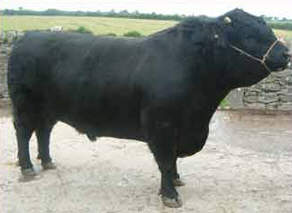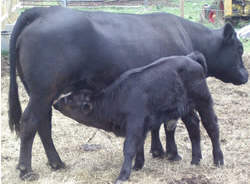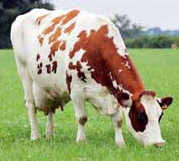



Welsh Black
History
The Welsh Black is a native British breed descended from cattle of Pre-Roman Britain in the rough mountain and hill country of Wales. There is evidence that the breed, or its forerunners, existed in Roman times and it has been suggested that the breed is based on cattle from the Iberian Peninsula.Certainly black cattle have been bred in Wales for well over 1,000 years and, as in Scotland and many other parts of Britain, were often used as currency. This gave rise to the description of the Welsh Black as "the black gold from the Welsh hills".
 |
| Photo courtesy of Bridin, www.bridin.co.uk |
The successful intermingling of these types over the past 90 years has resulted in an optimum sized animal with an emphasis on beef production. The unique traits of the breed are a result of this heredity and environment.
Characteristics
The majority of Welsh Blacks are horned and black, varying from rusty black to jet black, with some white permitted on the underline behind the navel.The red recessive gene occasionally appears in a black herd and without exception breeds true. The red animal has no black genes and a red bull on a red cow will produce a red calf.
There are naturally polled Welsh Blacks available in increasing numbers, both Black and Red.
This hardy breed that provides high quality meat and milk has much to offer modern farming systems, with its ease of production and award-winning succulent meat.
The Welsh Black has been shown to perform well in a wide range of situations, including lowland beef breeding and finishing systems, its formidable reputation has been built on the breed’s capability to thrive on marginal and upland areas. There, its foraging habit, coupled with hardiness, ease of calving, and mothering ability, comes into its own.
Statistics
 |
| Photo courtesy of Bridin, www.bridin.co.uk |
- Hardiness and Adaptability - Neither cold or rain seem to worry them, as the experience of Canadian and New Zealand Breeders have confirmed. It is common to see them grazing happily in the open in driving rain or snow, when other types of cattle have gone in search of shelter. They develop a thick winter coat, which is usually shed in Spring.
- Ease of Calving - To some extent the harsh hills of Wales have culled the poor mothers and difficult calvers from the breed, so today the Welsh Black has evolved to be a breed noted for its ease of calving and its strong mothering instinct, where even the notoriously difficult European breed cross calf does not worry it. Welsh Black cows have a large reproductive tract which opens very wide before calving.
- Mothering Ability and Temperament - Once a calf is born it gets absolute priority on its mothers body resources, and even cows that have a difficult season will rear an excellent calf. It is not unusual in such circumstances to see a depleted looking cow suckling a big strong calf. A typical cow gives approximately 4000 litres in an even lactation of 9-11 months so that the calf is not confronted with a great surge of milk while too young to cope, yet still gets plenty later on when it needs the nourishment for maximum growth.
- Longevity - It is common for cows of 15 - 20 years to calve regularly and a female is considered in her prime when 10 - 15 years of age.
- Fertility - The bulls are noted for their fertility, able to join in any weather condition with a high sperm count.
- Rate of Growth - It is not generally appreciated that Welsh Blacks are amongst the fastest growing of the British breeds, both in their rate of growth and weights for age.
- Carcass Quality - The longer hair in winter and the excellent digestive system ensures maximum muscle and least amount of fat produced. At the same time the meat is generally marbled.
Comparative
Distribution
The Welsh Blacks are now established throughout the UK and over the past 30 years they have travelled to Canada, New Zealand, Australia, Spain, Germany, Saudi Arabia, Uganda and Jamaica.References (the above information was cited from the following sites)
www.rbta.org
www.welshblackcattlesociety.org
www.ansi.okstate.edu
www.bridin.co.uk


